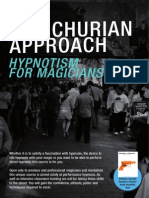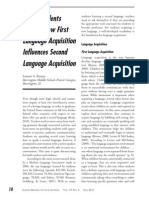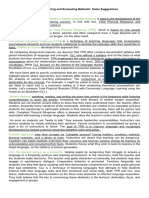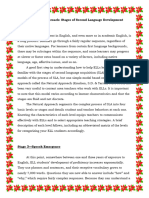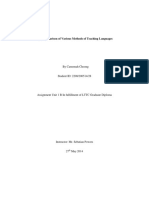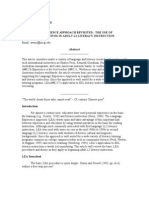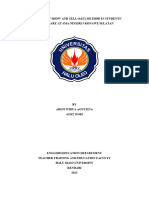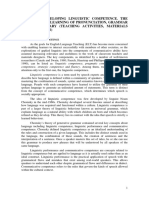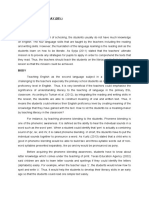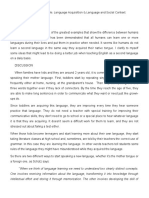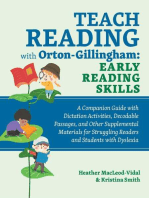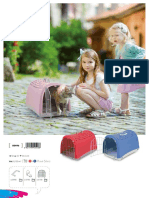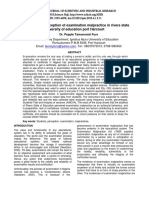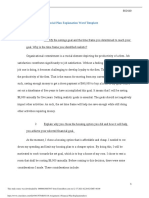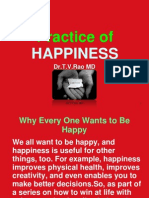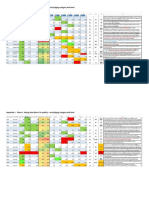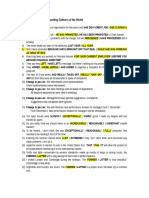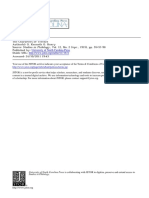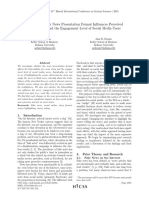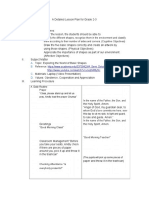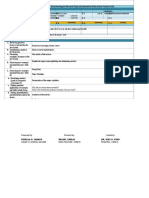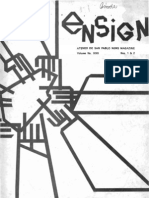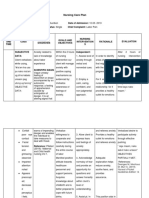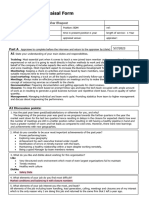ESL Strategies: What Works in Second Language Instruction
ESL Strategies: What Works in Second Language Instruction
Uploaded by
fatihgun007Copyright:
Available Formats
ESL Strategies: What Works in Second Language Instruction
ESL Strategies: What Works in Second Language Instruction
Uploaded by
fatihgun007Original Description:
Original Title
Copyright
Available Formats
Share this document
Did you find this document useful?
Is this content inappropriate?
Copyright:
Available Formats
ESL Strategies: What Works in Second Language Instruction
ESL Strategies: What Works in Second Language Instruction
Uploaded by
fatihgun007Copyright:
Available Formats
Fatih Gn, 2011554059
ESL Strategies: What Works in Second Language Instruction
Rosa Flores, M.Ed.
It is often said that the best way to develop students? English language skills is to
totally immerse them in an all-English environment in which they hear, repeat, read
and write English only. Of the many recent studies regarding second language
learners, none support this common misconception. On the contrary, research
shows that the most effective way for non-English speakers to develop both an
understanding of academic concepts and English language proficiency is through
their first language. IDRA's experience in the field supports this; the teachers with
whom we work often state that students with previous educational experience who
are given content in their own language seem to do better academically than
language minority students placed under an English-only curriculum.
First language instruction provides the comprehensible input students need to
develop academic concepts. The reality is, however, that many second language
learners in middle schools and high schools do not receive instruction in their
native language. These students face learning both a new language and required
academic content at the same time. This reality has serious implications for the
way in which instructors teach language skills.
The needs of the second language learners in our secondary schools are unique.
The following suggestions can be used in the development of effective English-asa-Second-Language (ESL) instructional activities that specifically address those
needs. These suggestions delineate and discuss the key indicators presently used
to evaluate effective ESL instructional activities. An ESL instructional activity is
successful when it meets the following criteria:
1. Emphasis is placed on second language acquisition rather than on language
learning. Krashen (1982) clearly distinguishes between language acquisition and
language learning. Second language acquisition, he propounds, is similar to first
language acquisition where there may not be conscious awareness that learning is
taking place. In other words, language acquisition is not a learned process; rather,
it is an acquired skill. Language learning he applies to that system of language
instruction in which learning grammar rules, by such techniques as paper and
pencil activities, occurs prior to students internalizing the new language.
Language acquisition is aided when the teacher gives comprehensible input by
providing opportunities for hearing and using the second language in a natural,
low-anxiety environment. While rote memory exercises and paper and pencil
activities may minimally increase the students' proficiency, second language
learners tend to respond much more readily to meaningful conversations and
game-like activities.
Excellent opportunities for language redundancy can be found in everyday songs
and chants. Songs and chants give second language learners opportunities to
engage in practice with the appropriate native-speaker stress and intonation, can
Fatih Gn, 2011554059
help make the new language meaningful, and can reinforce the vocabulary and
specific structures according to situational contexts. Excellent instructional
materials are available that contain songs, raps and chants for the second
language learner that can make this type of activity fun and relevant for the
student. Initial physical activities such as Asher's Total Physical Response (TPR)
should be incorporated whenever possible. To introduce new language concepts,
TPR uses oral and written commands to initiate students' physical movement,
somewhat like the game Simon Says... The relaxed TPR environment provides
real-life situations with lots of natural, comprehensible input and engages students
in a variety of listening activities to expose them to the sounds of the new
language. As students receive meaningful messages, they begin to respond with
one or two word answers; these short responses become the building blocks for
their later use of phrases and sentences.
Using the objects around the room, the school and the community can be a
particularly profitable strategy for secondary school students since most are ready
and able to transfer knowledge from the first to the second language. In using the
world around them as a learning tool, students focus on labeling or giving new
names to objects and concepts they've already learned. Teachers have found that
the labeling of objects around the classroom easily provides significant results.
Additionally, field trips have proven an exciting and effective way to help students
acquire a new language naturally. Concepts new to the students and/or the
student's culture requires opportunities for hands-on learning. Students need
to see it, hear it, andtouch it, whenever possible. Unfamiliar concepts should be
introduced experientially in a meaningful and relevant format using age-appropriate
materials. If a concept is unfamiliar even in the students' native language, it is best
presented in the native language first if possible.
The use of ESL methodology can be used to introduce unknown concepts by
teachers lacking proficiency in the students' native language. Meaningful second
language instruction provides the opportunity for students to become more
proficient in the target language. Vocabulary is learned most easily when it is
integrated into a significant context-related setting. Language transmits meaning
best when it is tied to concrete, physical objects or activities. For second language
acquisition, content area instruction should be an all day effort that takes
advantage of every opportunity to infuse the new language with meaning.
Teachers may be the only English-speaking models to which the student have
access. It is important, therefore, that teachers model correct usage of new
language while allowing students to make the mistakes that are an inherent and
important part of language acquisition. Every new step takes the second language
learner closer to the goal of proficiency, so students should be praised for their
efforts and achievements; they should never be made to feel embarrassed by a
lack of skill in the target language. Game-like activities make provisions for second
language learners to feel comfortable taking risks in using their new language.
Instructors should ensure that students understand the important concepts and key
words used in each activity. By focusing on the key elements and vocabulary, the
teacher not only provides students with opportunities to use the target language,
but opportunities to quickly acquire meaning as well. Better end results can be
obtained when textbook content has been extracted to produce lessons specifically
adated to target language acquisition.
The whole language approach focuses on learning from the general to the specific,
or from the whole to the part. This style of instruction provides the meaningful
contexts that help students grasp new concepts. Techniques such as Language
Experience Activities (LEA), Total Physical Response (TPR), chants, drama and
Fatih Gn, 2011554059
other performances, word banks and journal writing can contribute to the creation
of meaningful context for the students. When students are actively involved in
whole language development, they acquire the target language naturally.
Integrating a thematic curriculum centered around interesting themes can help
students engage. By linking content area subject matter to theme-related topics,
the instructor can facilitate students' transitions from one subject to the next.
2. Natural redundancy in the use of language is used to reinforce language
acquisition.
3. The whole body is recognized as an excellent tool for language acquisition.
4. Concrete examples and objects in the environment are used to encourage second
language acquisition.
5. New concepts are presented contextually in a participatory manner with extensive
opportunities for practice.
6. Instruction for language acquisition is focused on meaning.
7. Students are encouraged to take risks in order to acquire the new language.
8. Teachers establish a background and context for the natural acquisition of
language.
9. Whole language strategies are used as an excellent means for teachers to meet
the needs of second language learners.
10. Holistic, integrated, thematic instruction is best used to provide language-enriched
learning.
Teaching a second language can be an arduous and painful task, or it can be a fun
and rewarding experience. Second language learners can be apathetic or
enthusiastic students depending on their classroom experiences. As teachers, we
set the tone with our attitudes and expressions as well as with the activities in
which we choose to involve our classes. The criteria presented can help you
choose fun, informative activities that provide students with meaningful learning of
content as well as second language acquisition toward increasing their English
language proficiency.
Resources
Asher, James J. (1982). Learning Another Language Through Actions: The Complete Teacher's
Guidebook. Los Gatos, CA: Sky Oaks Productions.
Cummins, J. (1986). Empowering Minority Students: A Framework for Intervention. Harvard
Educational Review, 56 (1).
Krashen, S.D. (1982). Principles and Practice in Second Language Acquisition. Oxford: Pergomon.
Krashen S.D. & T.D. Terrell. (1983). The Natural Approach. San Francisco, CA: The Alemany Press.
Langer, J. A. & G. R. Tucker. (1990). Construction in School Literacy Tasks. American Educational
Research Journal, 27, 427-471.
Fatih Gn, 2011554059
In the article, firstly it is stated that the students who are given instructions using L1 seem to
do better that the ones who are given instructions using L2. So an English-only environment
is not always useful as it seems to be. But in many schools, second language learners do not
receive any instructions in their native language and they have difficulties as they have to be
successfull in both learning the language and the academic content.
The the article goes on with suggestions to give effective instructions in ESL classrooms.
Students learn language by learning grammar rules, by such techniques as paper and pencil
activities, etc. While these activities may improve the students proficiency, second language
learners tend to respond much more easily to meaningful conversations and game-like
activities. So, second language learners can engage in practice and reinforce the vocabulary
and specific structures according to situational contexts. As students start to receive
understandable input, they begin to respond with one or two word answers, which will be the
first steps for their use of the target language. Meaningful second language instruction also
provides the opportunity for students to become more proficient in the target language. If a
concept is unfamiliar even in the students' native language, it is best presented in the native
language first if possible.
Mostly teachers are the only English-speaking models to the students in schools. Therefore,
it is important for the teachers to allow the students to make mistakes while teaching the new
language. As the students make mistakes, they will get closer to language proficiency so the
students should never be made to feel embarrassed by lack of skills in the target language,
they should be praised for their efforts instead. By focusing on the key elements and
vocabulary, the teacher not only provides students with opportunities to use the target
language, but also opportunities to quickly acquire meaning as well.
To sum up, the article mainly states that the needs of the second language learners in
schools are important so the development of effective ESL instructional activities that
specifically address those needs would be beneficial. When students are actively involved in
whole language development, they acquire the target language naturally.
You might also like
- Targetedselection MG DdiDocument22 pagesTargetedselection MG DdiShaguftaAbbas100% (3)
- Messaging: beyond a lexical approach in ELTFrom EverandMessaging: beyond a lexical approach in ELTRating: 5 out of 5 stars5/5 (1)
- The Manchurian ApproachDocument2 pagesThe Manchurian ApproachArtist Metu20% (5)
- Teaching English to Speakers of Other LanguagesFrom EverandTeaching English to Speakers of Other LanguagesRating: 3 out of 5 stars3/5 (1)
- Second Language Acquisition Applied to English Language TeachingFrom EverandSecond Language Acquisition Applied to English Language TeachingRating: 4.5 out of 5 stars4.5/5 (2)
- Psych Test PrepDocument664 pagesPsych Test Prepchestrwu100% (2)
- Chittenden East Supervisory Union Cook Evaluation Form: Explanatory CommentsDocument3 pagesChittenden East Supervisory Union Cook Evaluation Form: Explanatory CommentsAnn Myril Chua TiuNo ratings yet
- Teaching Grammar For BeginnersDocument9 pagesTeaching Grammar For BeginnersHanzord NapoleonNo ratings yet
- 13100043HBET1303Doing Students Justice How L1 Acquisition Influences L2 PDFDocument6 pages13100043HBET1303Doing Students Justice How L1 Acquisition Influences L2 PDFblue_shylin50% (2)
- PDF TeylDocument30 pagesPDF Teylrebry_nurcahyonoNo ratings yet
- Ptlal ReviewerDocument7 pagesPtlal Reviewererikakimperez7No ratings yet
- Teaching English For Young Learners Using A Total Physical Response (TPR) MethodDocument8 pagesTeaching English For Young Learners Using A Total Physical Response (TPR) MethodDewi LestariNo ratings yet
- A Method and Approach For ELT LatestDocument5 pagesA Method and Approach For ELT LatestmayuritratiyaNo ratings yet
- English Language Teaching MethodDocument8 pagesEnglish Language Teaching MethodNadia Novernia Cristy KatuukNo ratings yet
- Session2 - Assignment - Reading Material - Teaching MethodsDocument7 pagesSession2 - Assignment - Reading Material - Teaching MethodsCarlos VeraNo ratings yet
- Improving The StudentsDocument36 pagesImproving The StudentsPipit Sulistya RiniNo ratings yet
- 11.how To Teach Speaking Skill: Related PapersDocument7 pages11.how To Teach Speaking Skill: Related PapersLilis KarmilaNo ratings yet
- Methods in Teaching Language Arts: Bicol University College of Education Daraga, Albay S.Y: 2020-2021Document18 pagesMethods in Teaching Language Arts: Bicol University College of Education Daraga, Albay S.Y: 2020-2021Joey PerezNo ratings yet
- Assignment 2 Write An Essay On The SeconDocument6 pagesAssignment 2 Write An Essay On The SeconMohamed BdiouiNo ratings yet
- Teaching Method - Direct Method 2Document5 pagesTeaching Method - Direct Method 2djoiajgNo ratings yet
- Teaching English As A Second Language: C. M. Recto Avenue, ManilaDocument8 pagesTeaching English As A Second Language: C. M. Recto Avenue, ManilaFourth WallNo ratings yet
- Book Chapter Spiro 2013 Theories and MethodsDocument24 pagesBook Chapter Spiro 2013 Theories and Methodspingql2023No ratings yet
- Natural-Approach-STAGE-3-Speech-Emergence-and-Interactive-Teaching-Learning-Document7 pagesNatural-Approach-STAGE-3-Speech-Emergence-and-Interactive-Teaching-Learning-marycarolenefarrenNo ratings yet
- Language_Teaching_Refashioning_the_RoleDocument10 pagesLanguage_Teaching_Refashioning_the_RolepatriciamaeNo ratings yet
- Language Experience Story: Writing ActivityDocument11 pagesLanguage Experience Story: Writing ActivityHanie Balmedina-RazoNo ratings yet
- The Comparison of Various Methods of Teaching Languages: by Careemah ChoongDocument10 pagesThe Comparison of Various Methods of Teaching Languages: by Careemah ChoongahmedNo ratings yet
- Article - N - Techniques and Methods For Improving Reading SkillsDocument3 pagesArticle - N - Techniques and Methods For Improving Reading SkillseLockNo ratings yet
- SELT Reading KrashenDocument43 pagesSELT Reading Krashentrukson180% (5)
- Foreign Language AcquisitionDocument22 pagesForeign Language AcquisitionyansyarroyoNo ratings yet
- Second Language Teaching Method: A Paper To Fullfil A Given Assignment For "Psycholinguistics" SubjectDocument19 pagesSecond Language Teaching Method: A Paper To Fullfil A Given Assignment For "Psycholinguistics" SubjectAditya SaputraNo ratings yet
- FSU - ContentsDocument200 pagesFSU - Contentsd-fbuser-27243213No ratings yet
- 8 CHAPTER 2 Presenation Related Literature and StudiesDocument13 pages8 CHAPTER 2 Presenation Related Literature and StudiesBagong Sikat ESNo ratings yet
- Background of The Study: The Effects of Games in English Vocabulary Learning For Young LearnersDocument22 pagesBackground of The Study: The Effects of Games in English Vocabulary Learning For Young Learnerssurya megaNo ratings yet
- Chapter One: 1 Rudheford, Grammar in The Second Language Classroom, (New York. London: Prentice Hall, 1987) - P.9Document7 pagesChapter One: 1 Rudheford, Grammar in The Second Language Classroom, (New York. London: Prentice Hall, 1987) - P.9MalurRahmiNo ratings yet
- Benefits and Disadvantages of Games in Vocabulary Learning For Young LearnerDocument6 pagesBenefits and Disadvantages of Games in Vocabulary Learning For Young LearnerMiftah Awaludin As-safariNo ratings yet
- VOCABULARYDocument18 pagesVOCABULARYSudhiksha SurmughiNo ratings yet
- Issues in Teaching Grammar and AssesmentDocument2 pagesIssues in Teaching Grammar and AssesmentJocelyn Flores GamboaNo ratings yet
- Maam Alan Research BasedDocument16 pagesMaam Alan Research BasedLeslyn Babato Bangibang DiazNo ratings yet
- Role Language in Teaching of Physics BkparidaDocument21 pagesRole Language in Teaching of Physics BkparidaAyan PandaNo ratings yet
- The Reading Matrix Vol. 2, No. 1, April 2002Document8 pagesThe Reading Matrix Vol. 2, No. 1, April 2002Saoussen Madoui TraductriceNo ratings yet
- Language Learning MitsutomiDocument4 pagesLanguage Learning MitsutomiElkhansa AsnaNo ratings yet
- Proposal Arini Widya AgustinaDocument14 pagesProposal Arini Widya AgustinaariniwdyagstnNo ratings yet
- English in An Engaging and Interactive Classroom: Review of Methods and MethodologyDocument15 pagesEnglish in An Engaging and Interactive Classroom: Review of Methods and Methodologykewin_walterNo ratings yet
- Lesson 4Document7 pagesLesson 4BlodiMerNo ratings yet
- Effective Strategies For Teaching Vocabulary To Young LearnersDocument8 pagesEffective Strategies For Teaching Vocabulary To Young LearnersHai NguyenNo ratings yet
- How To Teach Speaking Skill?Document6 pagesHow To Teach Speaking Skill?Rafi Cliquerznapasha UntukmuslamanyaNo ratings yet
- Listening Comprehension Need and NeglectDocument8 pagesListening Comprehension Need and NeglectmychiefNo ratings yet
- Project Midterm ELT Contemporary Methods and StrategyDocument9 pagesProject Midterm ELT Contemporary Methods and StrategyFajar Abimanyu ANo ratings yet
- CULTUREDocument5 pagesCULTURESheryn AstibeNo ratings yet
- Task 3: Academic Essay (20%)Document4 pagesTask 3: Academic Essay (20%)Living LegacyNo ratings yet
- Cognate Midterm ExamDocument4 pagesCognate Midterm ExamJerico N. loberianoNo ratings yet
- Language Learning and AcquisitionDocument3 pagesLanguage Learning and AcquisitionErwin Santana OrtegaNo ratings yet
- Issues in TEFL - S3 - English2017 - Besse DarmawatiDocument12 pagesIssues in TEFL - S3 - English2017 - Besse DarmawatiFebby Sarah CilcilaNo ratings yet
- Lecturer: Nenni Triana Sinaga, S.S., M.PD.: Teaching The Four Language Skills in Primary Efl ClassroomDocument9 pagesLecturer: Nenni Triana Sinaga, S.S., M.PD.: Teaching The Four Language Skills in Primary Efl Classroomriris romauli pasaribuNo ratings yet
- Eng 1 ModuleDocument27 pagesEng 1 ModuleSherha SaddalaniNo ratings yet
- Chapter 7: The Teaching of The Language Subjects: Lesson 1: Mother Tongue-Based Multilingual Education (MTB-MLE)Document20 pagesChapter 7: The Teaching of The Language Subjects: Lesson 1: Mother Tongue-Based Multilingual Education (MTB-MLE)crystal ann tadiamonNo ratings yet
- Readings For EFL TeachersDocument30 pagesReadings For EFL TeachersAtef Abd El-KhalekNo ratings yet
- Teach Reading with Orton-Gillingham: Early Reading Skills: A Companion Guide with Dictation Activities, Decodable Passages, and Other Supplemental Materials for Struggling Readers and Students with DyslexiaFrom EverandTeach Reading with Orton-Gillingham: Early Reading Skills: A Companion Guide with Dictation Activities, Decodable Passages, and Other Supplemental Materials for Struggling Readers and Students with DyslexiaNo ratings yet
- Linus Pet CarrierDocument2 pagesLinus Pet Carrierfatihgun007No ratings yet
- 2009-2010 12.sınıf Anadolu Lisesi İngilizce 2.dönem 1.yazılı Soruları-1Document3 pages2009-2010 12.sınıf Anadolu Lisesi İngilizce 2.dönem 1.yazılı Soruları-1fatihgun007No ratings yet
- Characteristics of YlsDocument16 pagesCharacteristics of Ylsfatihgun007No ratings yet
- Cefr and Listening ActivitiesDocument19 pagesCefr and Listening Activitiesfatihgun007No ratings yet
- A2 ESL EFL Lesson PlanDocument3 pagesA2 ESL EFL Lesson Planfatihgun007No ratings yet
- Teaching Language SkillsDocument6 pagesTeaching Language Skillsfatihgun007No ratings yet
- Kirkgoz-Your Practicum ExperienceDocument3 pagesKirkgoz-Your Practicum Experiencefatihgun007No ratings yet
- Using and Adapting The CourseDocument4 pagesUsing and Adapting The Coursefatihgun007No ratings yet
- Teaching Practice Assessment Questionnaire: School: ClassDocument1 pageTeaching Practice Assessment Questionnaire: School: Classfatihgun007No ratings yet
- Yeni Microsoft Word BelgesiDocument1 pageYeni Microsoft Word Belgesifatihgun007No ratings yet
- Yeni Microsoft Word BelgesiDocument1 pageYeni Microsoft Word Belgesifatihgun007No ratings yet
- Students Perception of Examination Malpractice in Rivers State University of Education Port HarcourtDocument7 pagesStudents Perception of Examination Malpractice in Rivers State University of Education Port HarcourtsardinetaNo ratings yet
- Reinhardt Design ModelsDocument18 pagesReinhardt Design ModelsNancy Al-AssafNo ratings yet
- ECO110 Assignment 2 Financial Plan ExplanationDocument4 pagesECO110 Assignment 2 Financial Plan ExplanationHugsNo ratings yet
- Happiness, Practice of HappinessDocument29 pagesHappiness, Practice of Happinesstummalapalli venkateswara raoNo ratings yet
- Trend and Fad Lesson 1 Week 1 2 2Document11 pagesTrend and Fad Lesson 1 Week 1 2 2Pj ChavezNo ratings yet
- Aura (Extracts From Alice Bailey Books)Document3 pagesAura (Extracts From Alice Bailey Books)Anonymous wphSiUcdYHNo ratings yet
- 4 Phonology Scale ReportDocument12 pages4 Phonology Scale ReportGEORGEJUNGCOCAINENo ratings yet
- Midterm Desma 9Document15 pagesMidterm Desma 9ThaSupaflyNo ratings yet
- Review Exercise UndersDocument3 pagesReview Exercise Undersapi-306007245No ratings yet
- DVI Physical Ed Position PaperDocument3 pagesDVI Physical Ed Position PaperAPOLONIO SHIRLEYNo ratings yet
- Henry (1915) The Characters of Terence - Studies in Philology 12, 2, Pp. 55-98Document44 pagesHenry (1915) The Characters of Terence - Studies in Philology 12, 2, Pp. 55-98Enzo DiolaitiNo ratings yet
- Diwa PasiklabanDocument2 pagesDiwa Pasiklabanlornalyn garciaNo ratings yet
- Dark Adaptation.: R - M - Shapley and C. Enroth-CugellDocument1 pageDark Adaptation.: R - M - Shapley and C. Enroth-CugellAkicaNo ratings yet
- PR2 Group2 FinalDocument27 pagesPR2 Group2 FinalMary Rose ManalotoNo ratings yet
- Jennifer Graziano Sentencing 04-2001Document18 pagesJennifer Graziano Sentencing 04-2001Reality TV ScandalsNo ratings yet
- 2.news Presentation FormatDocument11 pages2.news Presentation Formatteff_ssfNo ratings yet
- Detailed Lesson Plan For Shapes Grade 1Document10 pagesDetailed Lesson Plan For Shapes Grade 1Avryl Hari NinoNo ratings yet
- Brainstorming For Research Topics (Continuation of The Activity-Based On CG)Document2 pagesBrainstorming For Research Topics (Continuation of The Activity-Based On CG)RonellaSabadoNo ratings yet
- Ensign November 1977Document16 pagesEnsign November 1977Walter TanNo ratings yet
- The Importance of PronunciationDocument17 pagesThe Importance of PronunciationMansoor KhanNo ratings yet
- Drug Ang NCPDocument9 pagesDrug Ang NCPMelanie GaledoNo ratings yet
- Managing OD ProcessDocument54 pagesManaging OD ProcessSf I-cheok100% (1)
- Siva SutrasDocument152 pagesSiva SutrasAspirant100% (7)
- Appraisal Form - JohnDocument3 pagesAppraisal Form - JohnMilestone Institute of TechnologyNo ratings yet
- InfographicDocument1 pageInfographicapi-593931076No ratings yet
- 20 Questions Directors of Not-For-Profit Organizations Should Ask About Strategy and Planning PDFDocument36 pages20 Questions Directors of Not-For-Profit Organizations Should Ask About Strategy and Planning PDFHC1990No ratings yet



